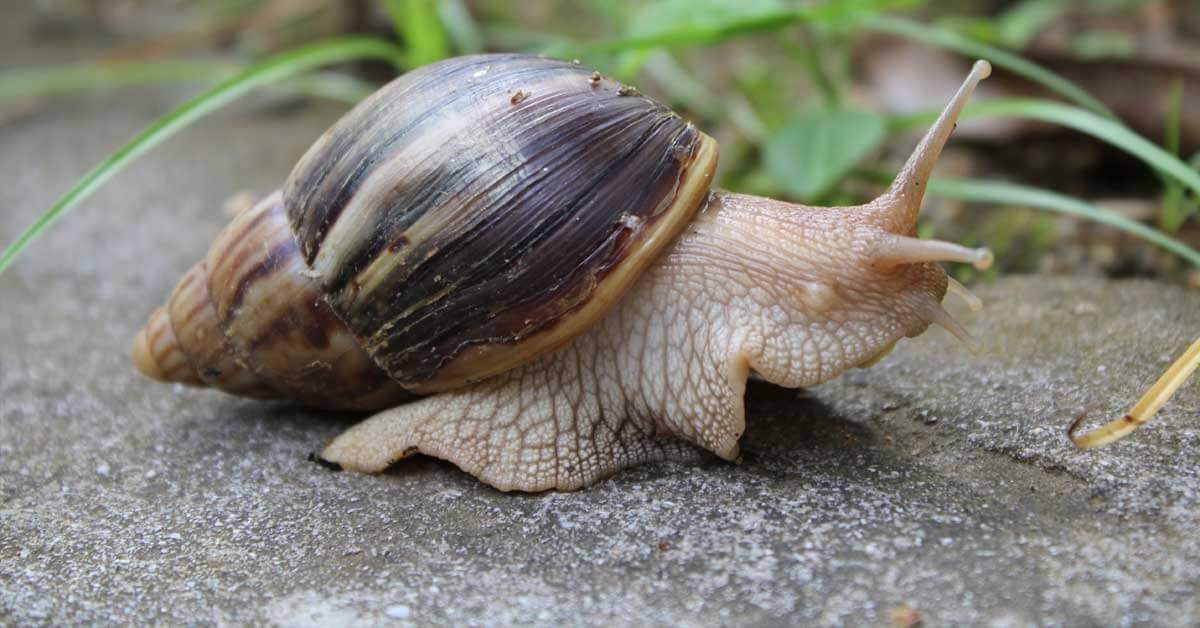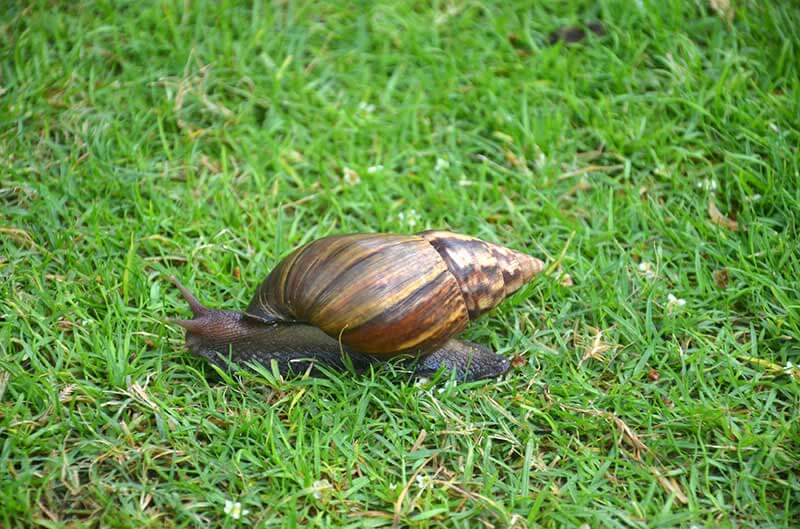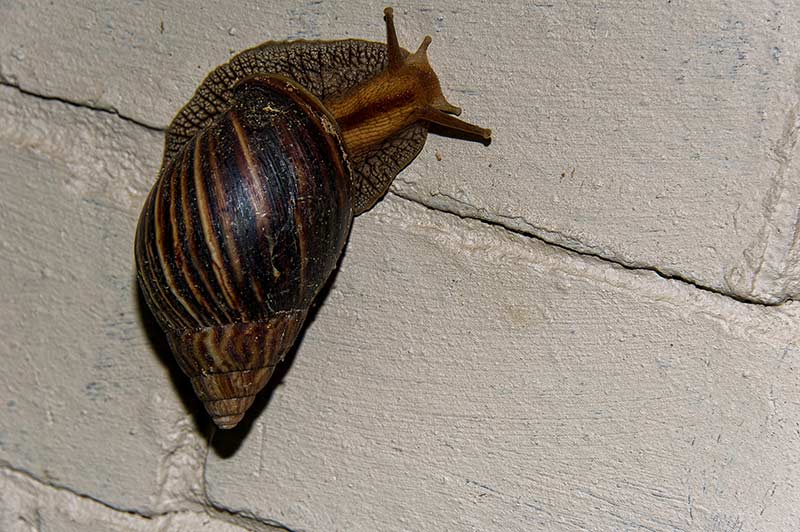How to Identify and Control Giant African Snails

At nearly 8 inches long and up to 5 inches in diameter, the Giant African Snail is one of the largest land snails in the world. It's also considered one of the most destructive. While it's no surprise that the snail's size made it a popular classroom exhibit and a target for exotic pet enthusiasts, these misguided interests, along with accidental imports, have left the United States with a serious pest problem. The U.S. Department of Agriculture's Animal and Plant Health Inspection Service (APHIS) now includes the Giant African Snail on its list of top national pest threats. Florida and Hawaii are already under quarantine and 14 other states are prime targets for invasions,3 but even cold northern states are at risk from the species.1
How Giant African Snails Have Spread
As the name suggests, the Giant African Snail is native to Africa, but it has spread through accidental import and intentional smuggling. The first record of this snail in the continental United States dates back to the late 1940s in a California seaport. Officials detected the invasion promptly, and eradication was swift. Over the years, the Giant African Snail has been discovered in several states, from Arizona to Wisconsin, in cases where confined snails were in public exhibits or private collections.2 Although it is illegal to possess live Giant African Snails in the U.S. without a USDA permit,5 officials regularly intercept these pests hidden in luggage on international flights.2
The current infestation in Florida is not the state's first. In 1966, a boy returning from Hawaii brought three of the snails with him, and his grandmother eventually put them into her garden. It took the state nearly a decade and one million dollars to eradicate the pests, which had grown to number more than 18,000 by 1973. It's estimated that agricultural losses would have reached 11 million if the pest had not been destroyed.2 In 2011, the Giant African Snail was again discovered in Florida. Eradication is still underway.

Why Giant African Snails Pose A Threat
Giant African Snails are highly invasive, adaptable creatures that constitute a significant threat to agricultural crops, natural resources and human health. Released into the environment, they're known to consume more than 500 types of plants, including many common vegetables, fruits and ornamentals. They're even known to eat house paint and stucco.1 Giant African Snails also can carry several plant and animal pathogens, including a parasitic nematode capable of causing meningitis in humans.2

The snail's range is limited by cold temperatures and moisture, as well as soil calcium needed for its shell. However, APHIS predicts that the snail's range could expand in the U.S. as far north as Maryland in the east, down across the southern states, and west through California and the entire Pacific Northwest.2 Officials also warn that Giant African Snails may survive northern cold and snow in a sluggish, hibernation-like state, and survive as far north as New Jersey and Colorado.1,4
Part of the threat the Giant African Snail poses is its ability to reproduce rapidly, giving new meaning to the expression “at a snail's pace." They can reach reproductive age in as little as five to six months and live nearly decade. Though they mate to reproduce, adults have both male and female sexual organs. After a single mating, the snail can lay multiple batches of viable eggs for more than one year. Eggs can hatch in as little as 11 days,2 with eggs from a single snail totaling more than 1,200 per year.1
How You Can Help Fight Giant African Snails
Good sanitation practices in your lawn and garden help expose and eliminate favorite Giant African Snail hideaways such as damp leaves, garden debris, logs or overturned flower pots. As you may imagine, the snail's presence can be devastating. Extensive chewing damage on plants, large mucus and slime trails, and large, ribbon-like feces are evidence these snails may be at work. They generally stay relatively close to the nest, feeding during nighttime hours and early morning, but they'll also feed on overcast days when soil is moist. During dry periods, they may burrow into soil where they can stay protected and inactive for one year or even longer. 2,5

Despite their size, Giant African Snails are vulnerable to the same types of snail controls used to fight smaller snails and slugs. While several effective products exist, some baits can unintentionally attract pets and other animals. However, baits with the active ingredient iron phosphate, which naturally occurs in soil, or the chelated form of iron known as sodium ferric EDTA can be used around pets and wildlife. As an added plus, people and pets can reenter treated areas immediately. The University of Florida advises that iron-based bait is effective against Giant African Snails.4
Corry's Slug & Snail Killer with sodium ferric EDTA is a highly effective bait that attract and kill Giant African Snails. Used according to label instructions, these easy-to-use products can be applied throughout your lawn and gardens — even around vegetables right up to the day of harvest. Snails eat the bait, stop feeding immediately, then hide and die. Any uneaten bait degrades naturally.
If you find a Giant African Snail, contact your state USDA office or plant pest control agency immediately. If you must handle snails, wear gloves and avoid bodily contact, particularly with your eyes, nose and mouth. Know the quarantine regulations for your region, and follow them closely.
Corry's and the Central Garden family of lawn and garden brands are committed to helping you protect your home and family from the threat of invasive pests and helping you enjoy your lawn and garden to its fullest.
Sources:
1. Hungry Pests, “Giant African Snail," USDA Animal and Plant Health Inspection Service.
2. Michalak, Patricia S., ed., “New Pest Response Guidelines. Giant African Snails: Snail Pests in the Family Achatinidae," USDA-APHIS, 2005.
3. USDA Pest Tracker, “States Affected by Giant African Snail," USDA Animal and Plant Health Inspection Service.
4. Capinera, John, “Giant African Land Snail in Florida," University of Florida, August 2014.
5. Solutions for Your Life, Miami-Dade County, "Giant African Land Snail," University of Florida.

